New Aspects to Greenhouse Gas Mitigation Policies for Low Carbon Cities
Abstract
:1. Introduction
2. Materials and Methods
- -
- Engine Volume: L
- -
- Horsepower: hp
- -
- Torque: Nm/rpm
- -
- Distance travelled: km
- -
- Fuel consumption: L/100 km
- -
- Εmissions of CO2, CO: g/km
- -
- Emissions of NOx, THC, CH4: mg/km
- -
- Emissions of PM: Particle Number/km
3. Results and Discussion
3.1. Vehicle’s Characteristics
3.2. Emission Standards
3.3. Fuel Properties
3.4. Exhaust Emissions
4. Conclusions
Author Contributions
Conflicts of Interest
References
- Intergovernmental Panel for Climate Change, 2006: 2006 IPCC Guidelines for National Greenhouse Gas Inventories. Available online: http://www.ipcc-nggip.iges.or.jp/public/2006gl/index.html (accessed on 10 December 2015).
- Simpson, I.J.; Blake, D.R.; Rowland, F.S.; Chen, T.Y. Implications of the recent fluctuations in the growth rate of tropospheric methane. Geophys. Res. Lett. 2002, 29, 117:1–117:4. [Google Scholar] [CrossRef]
- Dlugokencky, E.J.; Houweling, S.; Bruhwiler, L.; Masarie, K.A.; Lang, P.M.; Miller, J.B.; Tans, P.P. Atmospheric methane levels off: Temporary pause or a new steady-state? Geophys. Res. Lett. 2003, 30. [Google Scholar] [CrossRef]
- NOAA. National Oceanic and Atmospheric Administration, Interactive Atmospheric Data Visualization, 2003–2008 Airborne Methane Mixing Ratios Measured 1000–2000 Meters above Sea Level over Trinidad Head, California. 2008. Available online: http://www.esrl.noaa.gov/gmd/ccgg/iadv (accessed on 25 September 2008). [Google Scholar]
- Baumert, K.; Herzog, T.; Jonathan, P. Navigating the Numbers Greenhouse Gas Data and International Climate Policy; World Resources Institute: Washington, DC, USA, 2005. [Google Scholar]
- Annual European Union Greenhouse Gas Inventory 1990–2010 and Inventory Report 2012. Available online: http://www.eea.europa.eu/publications/european-union-greenhouse-gas-inventory-2012 (accessed on 20 December 2015).
- Nylund, N.O.; Erkkilä, K.; Lappi, M.; Ikonen, M. Transit Bus Emission Study: Comparison of Emissions from Diesel and Natural Gas Buses; VTT Technical Research Centre of Finland: Helsinki, Finland, 15 October 2004. [Google Scholar]
- Environment Canada. Global Warming Potentials. 2011. Available online: http://www.ec.gc.ca/ges-ghg/default.asp?lang=En&n=CAD07259-1 (accessed on 28 July 2015).
- Climate Action. 2015. Available online: http://ec.europa.eu/clima (accessed on 9 August 2015).
- International Energy Agency. The Contribution of Natural Gas Vehicles to Sustainable Transport. International Energy Agency Working Paper. 2010. Available online: http://www.iea.org/publications/freepublications/publication/natural_gas_vehicles.pdf (accessed on 6 December 2015).
- Takeshita, T. Assessing the co-benefits of CO2 mitigation on air pollutants emissions from road vehicles. Appl. Energy 2012, 97, 225–37. [Google Scholar] [CrossRef]
- Nanaki, E.; Koroneos, C. Comparative LCA of the use of biodiesel, diesel and gasoline for transportation. J. Clean. Prod. 2012, 20, 14–19. [Google Scholar] [CrossRef]
- Nanaki, E.A.; Koroneos, C.J.; Xydis, G.A.; Rovas, D. Comparative Environmental Assessment of Athens Urban Buses—Diesel, CNG and Biofuel Powered. Transp. Policy 2014, 35, 311–318. [Google Scholar] [CrossRef]
- Adcock, J.; Allen, B.; Cleary, R.; Dobbins, C.; Grooms, L.; Hayzen, G.; Hutcheson, S.; Johnson, M.; Johnston, B.; Jordan, B.; et al. Design and Construction of the University of Tennessee, Knoxville FutureTruck 2000/2001 Parallel Hybrid Vehicle; SAE Technical Paper 2002-01-1213; SAE International: Warrendale, PA, USA, 2002. [Google Scholar]
- Andrews, G.; Ahamed, F.; Li, H. Condensable and Gaseous Hydrocarbon Emissions and Their Speciation for a Real World SI Car Test; SAE Technical Paper 2007-01-0062; SAE International: Warrendale, PA, USA, 2007. [Google Scholar]
- Bach, C.; Lämmle, C.; Bill, R.; Soltic, P.; Dyntar, D.; Janner, P.; Boulouchos, K.; Onder, C.; Landenfeld, T.; Kercher, L.; et al. Clean Engine Vehicle A Natural Gas Driven Euro-4/SULEV with 30% Reduced CO2-Emissions; SAE Technical Paper 2004-01-0645; International: Warrendale, PA, USA, 2004. [Google Scholar]
- Baker, N.; Presnell, K. Investigation of the Effects of Wheel Slip on Vehicle Emissions and Fuel Economy; SAE Technical Paper 2006-01-1358; SAE International: Warrendale, PA, USA, 2006. [Google Scholar]
- Baronick, J.; Heller, B.; Lach, G.; Luf, H. Modal Measurement of Raw Exhaust Volume and Mass Emissions by SESAM; SAE Technical Paper 980047; SAE International: Warrendale, PA, USA, 1998. [Google Scholar]
- Bates, G.; Germano, S. Vehicle Tail Pipe Emissions—A Comparison of Natural Gas and Petrol Injection; SAE Technical Paper 942042; SAE International: Warrendale, PA, USA, 1994. [Google Scholar]
- Bell, A.; Yates, A. An Evaluation of the Speciated Exhaust Emissions Associated with South African Gasolines in an EU4 Vehicle. SAE Int. J. Fuels Lubr. 2009, 1, 1419–1432. [Google Scholar] [CrossRef]
- Bohac, S.V.; Han, M.; Jacobs, T.J.; López, A.J.; Assanis, A.N.; Szymkowicz, P.G. Speciated Hydrocarbon Emissions from an Automotive Diesel Engine and DOC Utilizing Conventional and PCI Combustion; SAE Technical Paper 2006-01-0201; SAE International: Warrendale, PA, USA, 2006. [Google Scholar]
- Brett, S.C.; Eade, D.; Hurley, R.G.; Gregory, D.; Collins, N.R.; Morris, D.; Collingwood, I.T. Evaluation of Catalysed Hydrocarbon Traps in the EGI System: Potential for Hydrocarbon Emissions Reduction; SAE Technical Paper 981417; SAE International: Warrendale, PA, USA, 1998. [Google Scholar]
- Cadle, S.H.; Groblicki, P.J.; Gorse, R.A.; Hood, J.; Korduba-Sawicky, D.; Sherman, M. A Dynamometer Study of off-Cycle Exhaust Emissions—The Auto/Oil Air Quality Improvement Research Program; SAE Technical Paper 971655; SAE International: Warrendale, PA, USA, 1997. [Google Scholar]
- Chan, T.; Meloche, E.; Kubsh, J.; Brezny, R.; Rosenblatt, D.; Rideout, G. Impact of Ambient Temperature on Gaseous and Particle Emissions from a Direct Injection Gasoline Vehicle and its Implications on Particle Filtration. SAE Int. J. Fuels Lubr. 2013, 6, 350–371. [Google Scholar] [CrossRef]
- Chandler, K.; Whalen, M.; Westhoven, J. Final Results From The State of Ohio Ethanol-Fueled Light-Duty Fleet Deployment Project; SAE Technical Paper 982531; SAE International: Warrendale, PA, USA, 1998. [Google Scholar]
- Crane, M.; Thring, R.; Podnar, D.; Dodge, L. Reduced Cold-Start Emissions Using Rapid Exhaust Port Oxidation (REPO) in a Spark-Ignition Engine; SAE Technical Paper 970264; SAE International: Warrendale, PA, USA, 1997. [Google Scholar]
- Delgado, R.; Paz, S. Effect of Different Ethanol-Gasoline Blends on Exhaust Emissions and Fuel Consumption; SAE Technical Paper 2012-01-1273; SAE International: Warrendale, PA, USA, 2012. [Google Scholar]
- Fanick, E.; Merritt, P.; Eng, K. Development of a Synthetic Diesel Exhaust. SAE Int. J. Engines 2009, 1, 65–70. [Google Scholar] [CrossRef]
- Fanick, E.; Whitney, K.; Bailey, B. Particulate Characterization Using Five Fuels; SAE Technical Paper 961089; SAE International: Warrendale, PA, USA, 1996. [Google Scholar]
- Gerini, A.; Monnier, G.; Bonetto, R. Ultra Low Emissions Vehicle Using LPG Engine Fuel; SAE Technical Paper 961079; SAE International: Warrendale, PA, USA, 1996. [Google Scholar]
- Goodfellow, C.; Gorse, R.; Hawkins, M.; McArragher, J. European Programme on Emissions, Fuels and Engine Technologies (EPEFE)—Gasoline Aromatics/E100 Study; SAE Technical Paper 961072; SAE International: Warrendale, PA, USA, 1996. [Google Scholar]
- Guenther, M.; Brown, K.; Landry, M.; Sherman, M.; Wu, D.Y. Refinement of a Bag Mini-Diluter System; SAE Technical Paper 2001-01-0212; SAE International: Warrendale, PA, USA, 2001. [Google Scholar]
- Guenther, M.; Wroza, L.; Polster, M. Update on Emissions Measurement Performance of a PZEV Test Cell; SAE Technical Paper 2006-01-1359; SAE International: Warrendale, PA, USA, 2006. [Google Scholar]
- Hammerle, R.H.; Ketcher, D.; Horrocks, R.W.; Lepperhoff, G.; Hüthwohl, G.; Lüers, B. Emissions from Diesel Vehicles with and without Lean NOx and Oxidation Catalysts and Particulate Traps; SAE Technical Paper 952391; SAE International: Warrendale, PA, USA, 1995. [Google Scholar]
- Hammerle, R.H.; Ketcher, D.A.; Horrocks, R.W.; Lepperhoff, G.; Hüthwohl, G.; Lüers, B. Emissions from Current Diesel Vehicles; SAE Technical Paper 942043; SAE International: Warrendale, PA, USA, 1994. [Google Scholar]
- Hartley, G.; Bykowski, B.; Welstand, S.; Lax, D. Effects of Catalyst Formulation on Vehicle Emissions with Respect to Gasoline Fuel Sulfur Level; SAE Technical Paper 1999-01-3675; SAE International: Warrendale, PA, USA, 1999. [Google Scholar]
- Heimrich, M.; Andrews, C. On-Board Hydrogen Generation for Rapid Catalyst Light-off; SAE Technical Paper 2000-01-1841; SAE International: Warrendale, PA, USA, 2000. [Google Scholar]
- Hoekman, S.; Jensen, T. Methanol Vehicle Emissions Round Robin Test Program; SAE Technical Paper 932773; SAE International: Warrendale, PA, USA, 1993. [Google Scholar]
- Jehlik, F.; Jones, M.; Shepherd, P.; Norbeck, J.M.; Johnson, K.; McClanahan, M. Development of a Low-Emission, Dedicated Ethanol-Fuel Vehicle with Cold-Start Distillation System; SAE Technical Paper 1999-01-0611; SAE International: Warrendale, PA, USA, 1999. [Google Scholar]
- Jemma, C.; Lance, D.; Shore, P. Speciation of Hydrocarbon Emissions from European Vehicles; SAE Technical Paper 922376; SAE International: Warrendale, PA, USA, 1992. [Google Scholar]
- Jeuland, N.; Dementhon, J.B.; Gagnepain, L.; Plassat, G.; Coroller, P.; Momique, G.C.; Belot, G.; Dalili, D. Performances and Durability of DPF (Diesel Particulate Filter) Tested on a Fleet of Peugeot 607 Taxis: Final Results; SAE Technical Paper 2004-01-0073; SAE International: Warrendale, PA, USA, 2004. [Google Scholar]
- Karavalakis, G.; Short, D.; Hajbabaei, M.; Vu, D.; Villela, M.; Russell, R.; Durbin, T.; Asa-Awuku, A. Criteria Emissions, Particle Number Emissions, Size Distributions, and Black Carbon Measurements from PFI Gasoline Vehicles Fuelled with Different Ethanol and Butanol Blends; SAE Technical Paper 2013-01-1147; SAE International: Warrendale, PA, USA, 2013. [Google Scholar]
- Karlsson, H.; Gåsste, J.; Åsman, P. Regulated and Non-regulated Emissions from Euro 4 Alternative Fuel Vehicles; SAE Technical Paper 2008-01-1770; SAE International: Warrendale, PA, USA, 2008. [Google Scholar]
- Koike, N.; Odaka, M. Methane and Nitrous Oxide (N20) Emission Characteristics from Automobiles; SAE Technical Paper 960061; SAE International: Warrendale, PA, USA, 1996. [Google Scholar]
- Kono, N.; Kobayashi, Y.; Takeda, H. Fuel Effects on Emissions from Diesel Vehicles Equipped with Advanced Aftertreatment Devices; SAE Technical Paper 2005-01-3700; SAE International: Warrendale, PA, USA, 2005. [Google Scholar]
- Korotney, D.; Rao, V.; Lindhjem, C.; Sklar, M. Reformulated Gasoline Effects on Exhaust Emissions: Phase III; Investigation on the Effects of Sulfur, Olefins, Volatility, and Aromatics and the Interactions Between Olefins and Volatility or Sulfur; SAE Technical Paper 950782; SAE International: Warrendale, PA, USA, 1995. [Google Scholar]
- Kwon, Y.K.; Bazzani, R.; Bennett, P.J.; Esmilaire, O.; Scorletti, P.; Morgan, T.D.B.; Goodfellow, C.L.; Lien, M.; Broeckx, W.; Liiva, P. Emissions Response of a European Specification Direct-Injection Gasoline Vehicle to a Fuels Matrix Incorporating Independent Variations in Both Compositional and Distillation Parameters; SAE Technical Paper 1999-01-3663; SAE International: Warrendale, PA, USA, 1999. [Google Scholar]
- Lance, D.; Andersson, J. Emissions Performance of Pure Vegetable Oil in Two European Light Duty Vehicles; SAE Technical Paper 2004-01-1881; SAE International: Warrendale, PA, USA, 2004. [Google Scholar]
- Lepperhoff, G.; Hüthwohl, G.; Lüers-Jongen, B.; Hammerle, R. Methods to Analyze Non-Regulated Emissions from Diesel Engines; SAE Technical Paper 941952; SAE International: Warrendale, PA, USA, 1994. [Google Scholar]
- Li, H.; Andrews, G.E.; Daham, B.; Bell, M.; Tate, J.; Ropkins, K. Impact of Traffic Conditions and Road Geometry on Real World Urban Emissions Using a SI Car; SAE Technical Paper 2007-01-0308; SAE International: Warrendale, PA, USA, 2007. [Google Scholar]
- Li, H.; Andrews, G.; Khan, A. VOC Emissions and OFP Assessment for Two Real World Urban Driving Cycles using a EURO 2 SI Car. SAE Int. J. Fuels Lubr. 2009, 1, 624–645. [Google Scholar] [CrossRef]
- Li, H.; Andrews, G.; Savvidis, D. Influence of Cold Start and Ambient Temperatures on Greenhouse Gas (GHG) Emissions, Global Warming Potential (GWP) and Fuel Economy for SI Car Real World Driving. SAE Int. J. Fuels Lubr. 2010, 3, 133–148. [Google Scholar] [CrossRef]
- Li, H.; Andrews, G.E.; Savvidis, D.; Daham, B.; Ropkins, K.; Bell, M.; Tate, J. Comparisons of the Exhaust Emissions for Different Generations of SI Cars under Real World; SAE Technical Paper 2008-01-0754; SAE International: Warrendale, PA, USA, 2008. [Google Scholar]
- Urban Driving Conditions; SAE Technical Paper 2008-01-0754; SAE International: Warrendale, PA, USA, 2008.
- Li, H.; Andrews, G.E.; Savvidis, D.; Daham, B.; Ropkins, K.; Bell, M.; Tate, J. Impact of Driving Cycles on Greenhouse Gas Emissions and Fuel Economy for SI Car Real World Driving. SAE Int. J. Fuels Lubr. 2009, 1, 1320–1333. [Google Scholar] [CrossRef]
- Li, H.; Andrews, G.; Savvidis, D.; Ropkins, K.; Tate, J.; Bell, M. Investigation of Regulated and Non-Regulated Cold Start Emissions using a EURO3 SI Car as a Probe Vehicle under Real World Urban Driving Conditions; SAE Technical Paper 2008-01-2428; SAE International: Warrendale, PA, USA, 2008. [Google Scholar]
- Luzenski, D.J.; Bedsole, K.T.; Hill, J.; Nagy, D.B.; Decarteret, S.S. Evaluation of Improved Bag Mini-Diluter System for Low Level Emissions Measurements; SAE Technical Paper 2002-01-0047; SAE International: Warrendale, PA, USA, 2002. [Google Scholar]
- Nagy, D.B.; Loo, J.; Tulpa, J.; Schroeder, P.; Middleton, R.; Morgan, C. Evaluation of the Bag Mini-Diluter and Direct Vehicle Exhaust Volume System for Low Level Emissions Measurement; SAE Technical Paper 2000-01-0793; SAE International: Warrendale, PA, USA, 2000. [Google Scholar]
- Newkirk, M.; Smith, L.; Payne, M.; Segal, J. Reactivity and Exhaust Emissions from an EHC-Equipped LPG Conversion Vehicle Operating on Butane/Propane Fuel Blends; SAE Technical Paper 961991; SAE International: Warrendale, PA, USA, 1996. [Google Scholar]
- Odaka, M.; Koike, N.; Ishii, H.; Suzuki, H.; Goto, Y. N2O Emissions from Vehicles Equipped with Three-Way Catalysts in a Cold Climate; SAE Technical Paper 2002-01-1717; SAE International: Warrendale, PA, USA, 2002. [Google Scholar]
- Payne, M.; Segal, J.; Newkirk, M.; Smith, L. Use of Butane as an Alternative Fuel-Emissions from a Conversion Vehicle Using Various Blends; SAE Technical Paper 952496; SAE International: Warrendale, PA, USA, 1995. [Google Scholar]
- Pentikäinen, J.; Rantanen, L.; Aakko, P. The Effect of Heavy Olefins and Ethanol on Gasoline Emissions; SAE Technical Paper 2004-01-2003; SAE International: Warrendale, PA, USA, 2004. [Google Scholar]
- Petit, A.; Jeffrey, J.; Palmer, F.; Steinbrink, R. European Programme on Emissions, Fuels and Engine Technologies (EPEFE)—Emissions from Gasoline Sulphur Study; SAE Technical Paper 961071; SAE International: Warrendale, PA, USA, 1996. [Google Scholar]
- Pischinger, S.; Umierski, M.; Hüchtebrock, B. New CNG Concepts for Passenger Cars: High Torque Engines with Superior Fuel Consumption; SAE Technical Paper 2003-01-2264; SAE International: Warrendale, PA, USA, 2003. [Google Scholar]
- Poola, R.B.; Sekar, R.; Ng, H.K.; Baudino, J.H.; Colucci, C.P. The Effects of Oxygen-Enriched Intake Air on FFV Exhaust Emissions Using M85; SAE Technical Paper 961171; SAE International: Warrendale, PA, USA, 1996. [Google Scholar]
- Przybyla, G.; Hadavi, S.; Li, H.; Andrews, G. Real World Diesel Engine Greenhouse Gas Emissions for Diesel Fuel and B100; SAE Technical Paper 2013-01-1514; SAE International: Warrendale, PA, USA, 2013. [Google Scholar]
- Rantanen, L.; Linnaila, R.; Aakko, P.; Harju, T. NExBTL—Biodiesel Fuel of the Second Generation; SAE Technical Paper 2005-01-3771; SAE International: Warrendale, PA, USA, 2005. [Google Scholar]
- Rimkus, W.A.; Larsen, R.P.; Zammit, M.G.; Davies, J.G.; Salmon, G.S.; Bruetsch, R.I. The Natural Gas Vehicle Challenge '92: Exhaust Emission Testing and Results; SAE Technical Paper 922387; SAE International: Warrendale, PA, USA, 1992. [Google Scholar]
- Ruetten, O.; Weinowski, R.; Baumgarten, H.; Habermann, K.; Umierski, M. Performance Improvement and Emission Reduction of NGV BiFuel Engines for Passenger Cars; SAE Technical Paper 2004-01-3468; SAE International: Warrendale, PA, USA, 2004. [Google Scholar]
- Sherman, M.; Akard, M.; Nakamura, H. Flame Ionization Detector Oxygen Quench Effects on Hydrocarbon Emission Results; SAE Technical Paper 2004-01-1960; SAE International: Warrendale, PA, USA, 2004. [Google Scholar]
- Schubert, P.F.; Russell, B.J.; Freerks, R.L.; DeVore, J.; Fanick, E.R. Impact of Ultra-Clean Fischer-Tropsch Diesel Fuel on Emissions in a Light Duty Passenger Car Diesel Engine; SAE Technical Paper 2002-01-2725; SAE International: Warrendale, PA, USA, 2002. [Google Scholar]
- Siegl, W.O.; Korniski, T.J.; Richert, J.F.O.; Chladek, E.; Weir, J.E.; Jensen, T.E. A Comparison of the Emissions from a Vehicle in Both Normal and Selected Malfunctioning Operation Modes; SAE Technical Paper 961903; SAE International: Warrendale, PA, USA, 1996. [Google Scholar]
- Sun, E.I.; McMahon, W.N.; Peterson, D.; Wong, J.; Stenersen, E.; Dallas, A.J. Evaluation of an Enhanced Constant Volume Sampling System and a Bag Mini Diluter for Near Zero Exhaust Emission Testing; SAE Technical Paper 2005-01-0684; SAE International: Warrendale, PA, USA, 2005. [Google Scholar]
- Turner, J.W.G.; Pearson, R.J.; Bell, A.; de Goede, S.; Woolard, C. Iso-Stoichiometric Ternary Blends of Gasoline, Ethanol and Methanol: Investigations into Exhaust Emissions, Blend Properties and Octane Numbers. SAE Int. J. Fuels Lubr. 2012, 5, 945–967. [Google Scholar] [CrossRef]
- Usmen, R.; Yassine, M.; Hartrick, M. Vehicle Exhaust Emissions Simulator—A Quality Control Tool to evaluate the Performance of Low Level Emission Sampling and Analytical Systems; SAE Technical Paper 2003-01-0391; SAE International: Warrendale, PA, USA, 2003. [Google Scholar]
- Webb, C.; Bykowski, B.; Weber, P.; McKinnon, D. Using Advanced Emission Control Systems to Demonstrate LEV II ULEV on Light-Duty Gasoline Vehicle; SAE Technical Paper 1999-01-0774; SAE International: Warrendale, PA, USA, 1999. [Google Scholar]
- Yassine, M.; Dhatt, R.; Laymac, T.; Ta, S. Using a Vehicle Exhaust Emission Simulator (VEES) as a Cross Check Tool for Emission Test Cell Correlation; SAE Technical Paper 2005-01-0687; SAE International: Warrendale, PA, USA, 2005. [Google Scholar]
- Yassine, M.; La Pan, M. Impact of Ethanol Fuels on Regulated Tailpipe Emissions; SAE Technical Paper 2012-01-0872; SAE International: Warrendale, PA, USA, 2012. [Google Scholar]
- Yassine, M.; Nayfeh, K.; Michell, R.; Chubert, E. Integration of Photoacoustic Innova Analyzer Within Bag Bench for Direct Measurement of Ethanol in Vehicle Emissions; SAE Technical Paper 2009-01-1518; SAE International: Warrendale, PA, USA, 2009. [Google Scholar]
- Zervas, E. Emissions of Non-regulated Pollutants from European Passenger Cars of Different Technology; SAE Technical Paper 2010-01-2226; SAE International: Warrendale, PA, USA, 2010. [Google Scholar]
- Zervas, E.; Panousi, E. Exhaust Methane Emissions from Passenger Cars; SAE Technical Paper 2010-01-2224; SAE International: Warrendale, PA, USA, 2010. [Google Scholar]
- Zhang, F.; Wang, J.H.; Tian, D.L.; Wang, J.X.; Shuai, S.J. Research on Unregulated Emissions from an Alcohols-Gasoline Blend Vehicle Using FTIR, HPLC and GC-MS Measuring Methods. SAE Int. J. Engines 2013, 6, 1126–1137. [Google Scholar] [CrossRef]
- Albino, V.; Ardito, L.; Dangelico, R.M.; Petruzzelli, A.M. Understanding the development trends of low-carbon energy technologies: A patent analysis. Appl. Energy 2014, 135, 836–854. [Google Scholar] [CrossRef]
- Lucas, S.V.; Loehr, D.A.; Meyer, M.E.; Thomas, J.J.; Gordon, E.E. Exhaust Emissions and Field Trial Results of a New, Oxygenated, Non-Petroleum-Based, Waste-Derived Gasoline Blending Component: 2-Methyltetrahydrofuran; SAE Technical Paper 932675; SAE International: Warrendale, PA, USA, 1993. [Google Scholar]
- Hirota, T.; Kojima, K.; Yakushiji, K.; Inoue, T. Effects of Exhaust Emission Control Devices and Fuel Composition on Speciated Emissions of S.I. Engines; SAE Technical Paper 922180; SAE International: Warrendale, PA, USA, 1992. [Google Scholar]

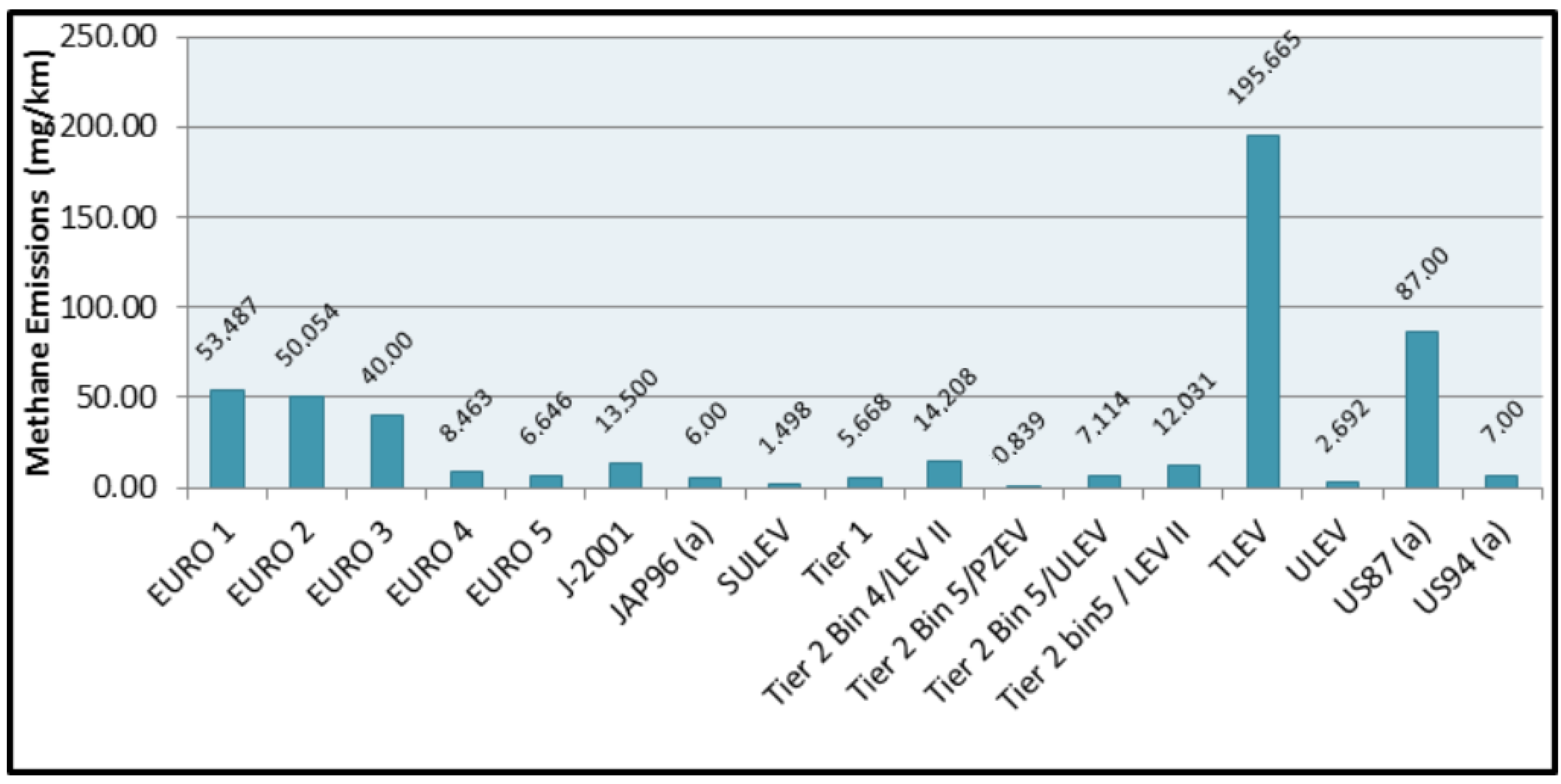
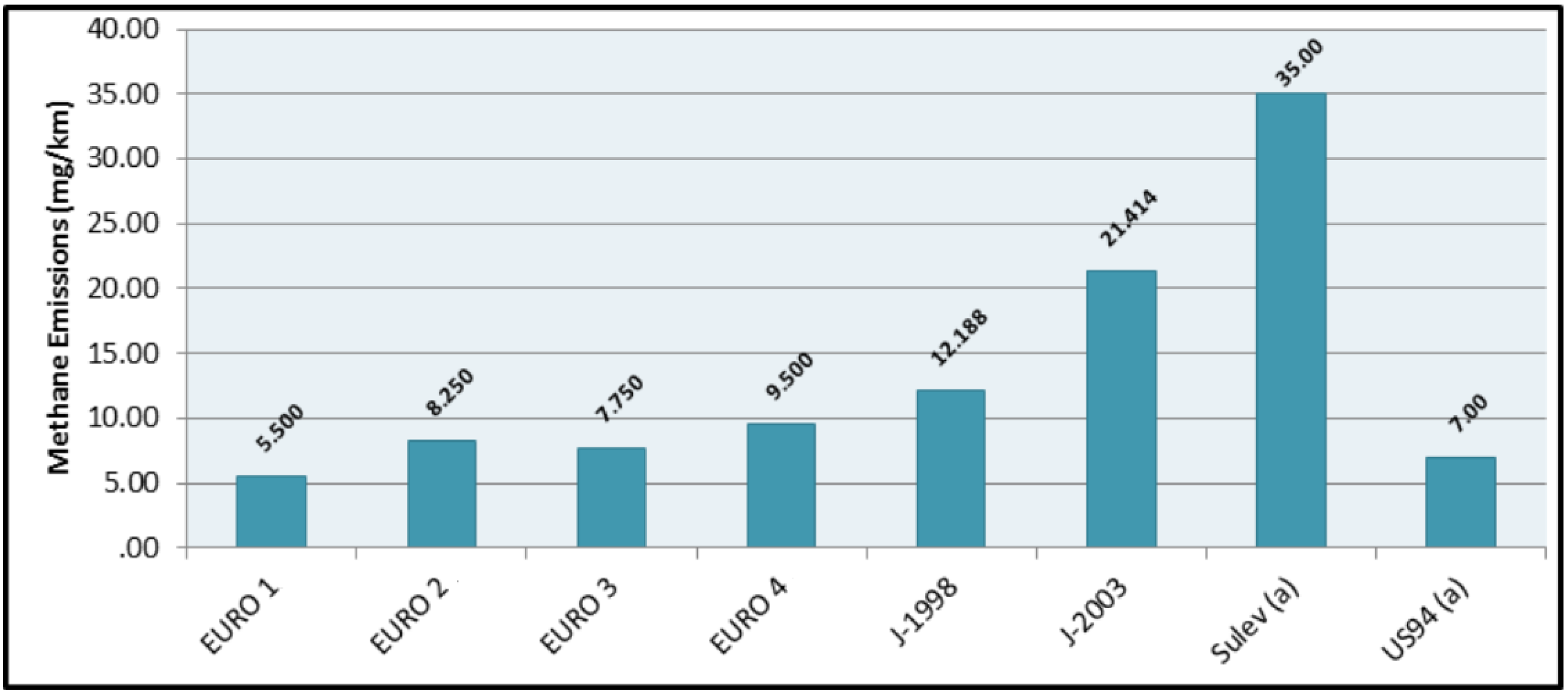
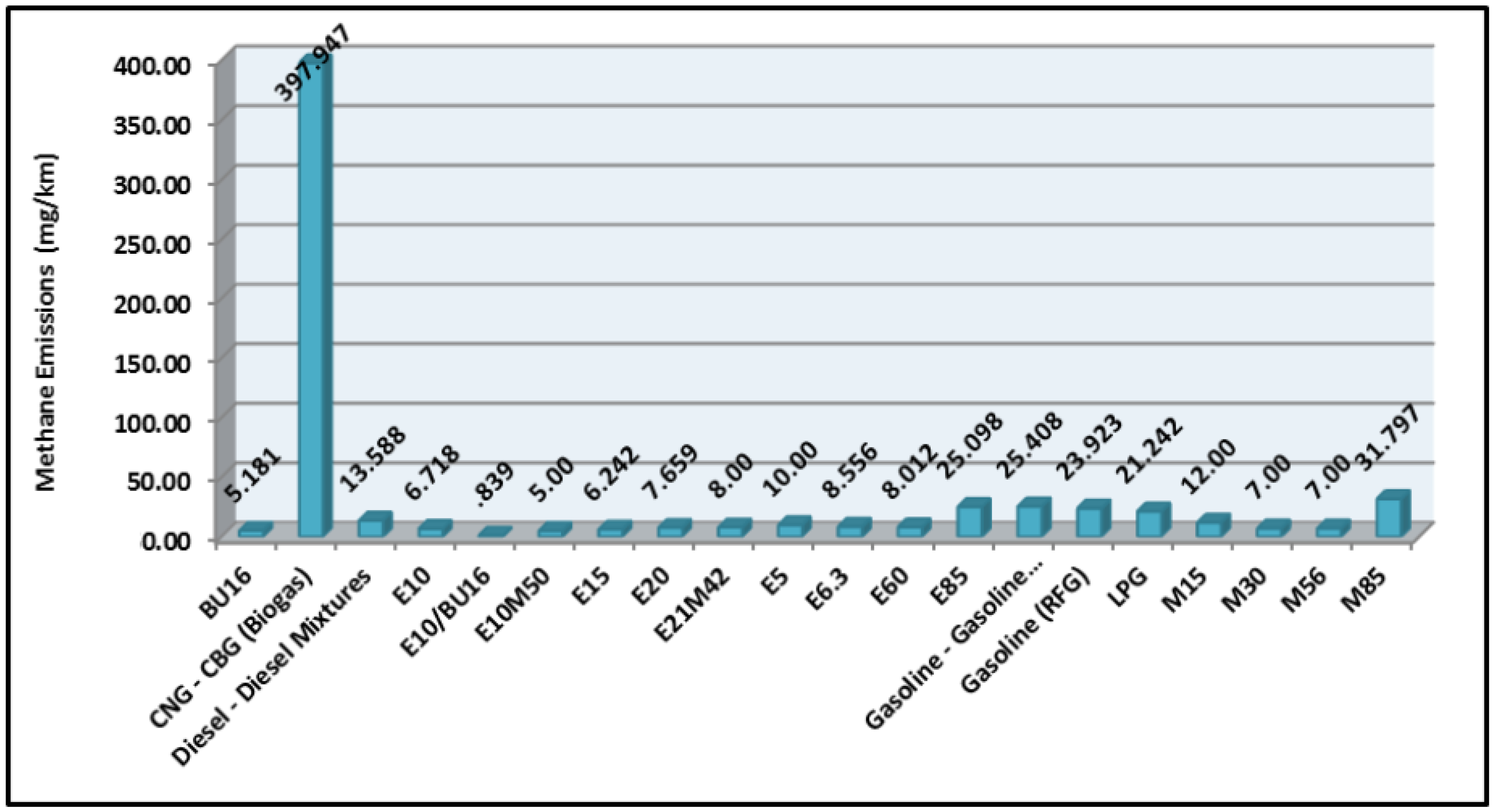
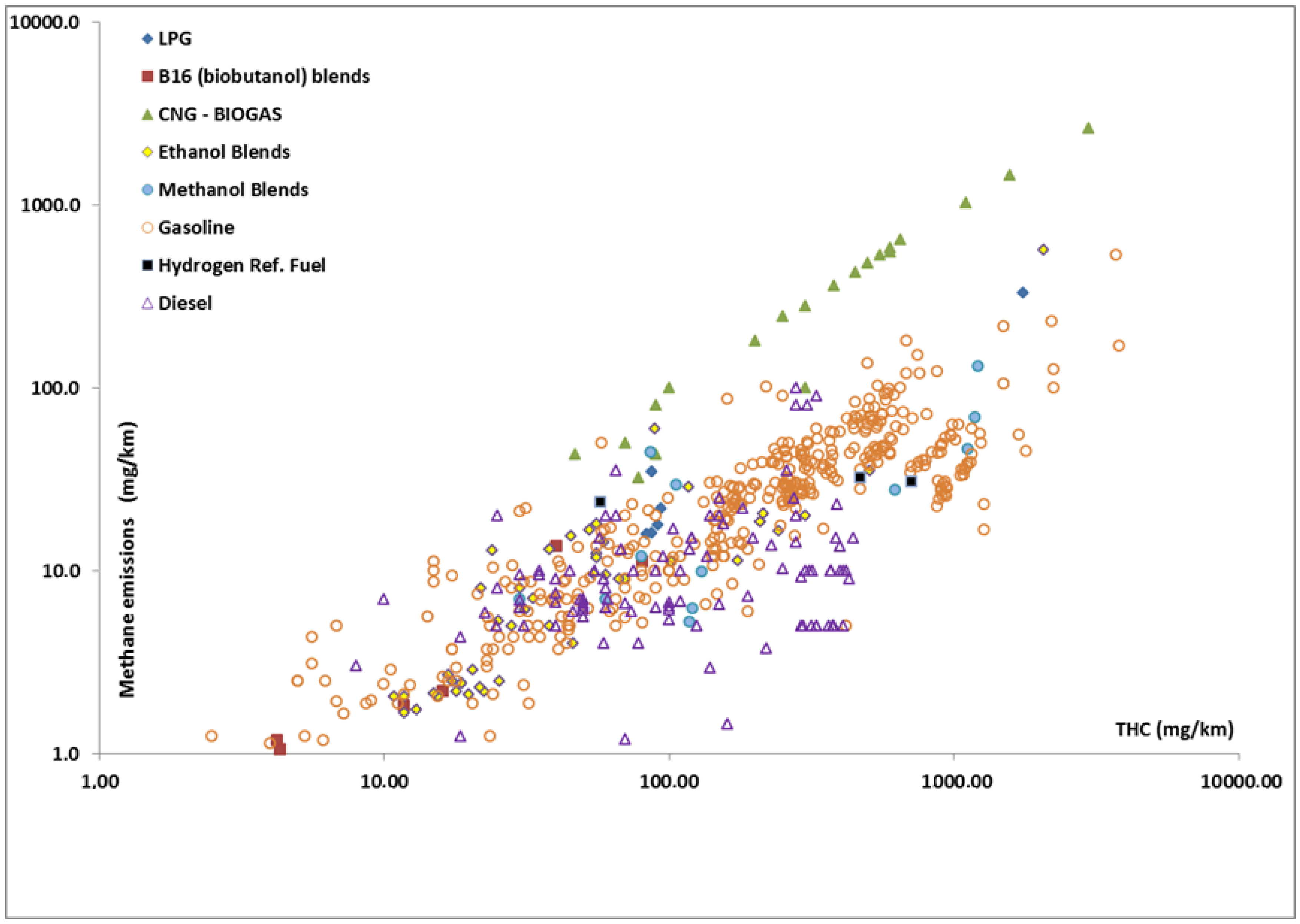
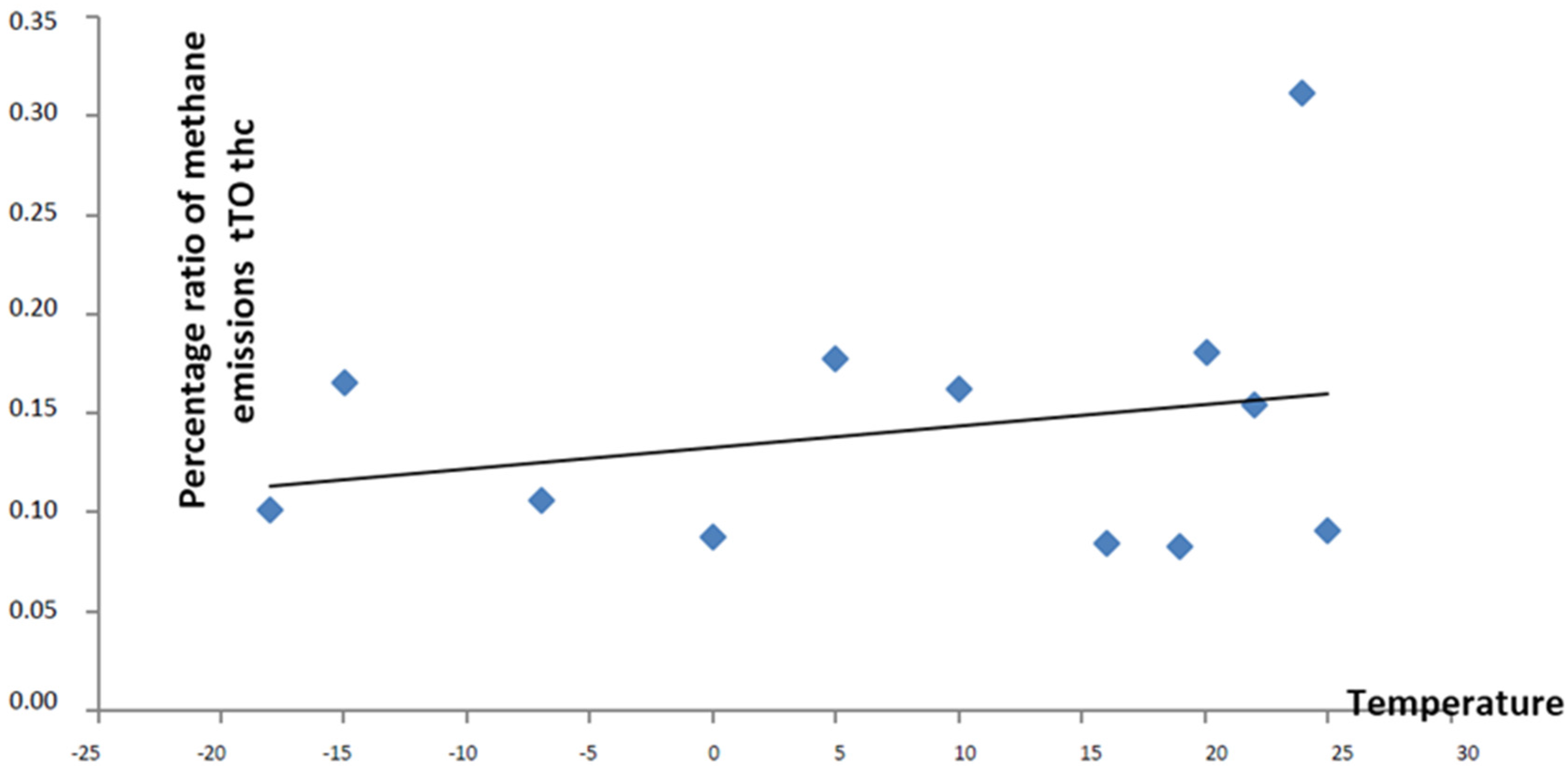
| Variable: Vehicles‘ Characteristics | Number of vehicles | Pearson’s Correlation Coefficient (r) |
|---|---|---|
| Engine Volume | ||
| All vehicles | 482 | −0.04 |
| EURO 4, EURO 5, Otto engine, Gasoline or gasoline blended fueled with exhaust after treatment system | 35 | −0.04 |
| Average of data regarding vehicles after 2000, TWC, Gasoline fueled, NEDC, EUDC, FTP-75, US06 | 10 | 0.241 |
| Average of vehicles after 2000, Diesel engine, Diesel fueled, EUDC, UDDS | 5 | 0.855 |
| Average of data regarding vehicles before 2000, TWC, Gasoline fueled, NEDC, EUDC, FTP-75, US06 | 13 | 0.045 |
| Horsepower | ||
| All vehicles | 101 | −0.265 |
| Test Temp. >10 °C, TWC | 82 | −0.327 |
| Test Temp. >10 °C, TWC, FTP-75, NEDC, EUDC | 55 | −0.231 |
| Compression Ratio | ||
| All vehicles | 217 | −0.162 |
| Cold test, Liquid fueled vehicles | 136 | 0.107 |
| No Cold test, Liquid fueled vehicles, FTP-75, NEDC, ECE, EUDC | 72 | −0.195 |
| Temperature | ||
| All vehicles | 117 | 0.03 |
| Otto engine, Gasoline or gasoline blended fueled | 110 | −0.12 |
| Hyundai Sonata-2011; Volvo S40-20111; Chrysler Town & Country-2001; Gasoline fueled | 21 | −0.78 |
| Renault Express—1994 | 3 | −0.90 |
| Exhaust after treatment system | ||
| All vehicles | 409 | 0.30 |
| Vehicles with Otto engine, with exhaust after treatment system | 409 | 0.33 |
| Vehicles after 2000 with Otto engine, with exhaust after treatment system | 57 | 0.60 |
| Vehicles after 2000 with Otto engine, with exhaust after treatment system—performing testing at ambient temperature | 37 | 0.97 |
| Vehicles with Diesel engine—performing testing at ambient temperature | 39 | 0.21 |
| Vehicles with Diesel engine—performing testing at ambient temperature—EUDC driving cycle | 11 | 0.68 |
| Variable: Fuel Properties | Number of vehicles | Pearson’s Correlation Coefficient (r) |
|---|---|---|
| Gasoline Composition | ||
| % aromatic hydrocarbons, standard driving conditions | 37 | 0.69 |
| % paraffin, standard driving conditions | 4 | 0.90 |
| % olefins, standard driving conditions | 28 | 0.60 |
| % O2, standard driving conditions | 6 | −0.88 |
| % MTBE, standard driving conditions | 3 | −0.46 |
| Gasoline | ||
| % Methanol, Standard driving conditions | 18 | −0.10 |
| Octane number, Vehicles with after treatment exhaust systems, Standard driving (no cold starts- cold conditions), Gasoline- gasoline blended fueled | 21 | 0.51 |
| Sulfur content | 18 | −0.10 |
| Ethanol Blends | ||
| % Ethanol, Standard driving conditions | 7 | 0.89 |
| Diesel | ||
| Sulfur content (ppm) | 9 | −0.47 |
| Cetane number | 19 | 0.63 |
| Variable: Exhaust Emissions | Number of vehicles | Pearson’s Correlation Coefficient (r) |
|---|---|---|
| CO2 emissions | ||
| All vehicles | 482 | 0.14 |
| Vehicles with Otto engine, Gasoline or gasoline blended fueled with exhaust after treatment system, after 1998 | 110 | 0.58 |
| Vehicles with Otto engine, Gasoline or gasoline blended fueled with exhaust after treatment system, after 1998, NEDC & F driving cycles | 42 | 0.65 |
| Vehicles with Diesel engine | 100 | 0.14 |
| Vehicles with Diesel engine, with exhaust after treatment system | 56 | 0.19 |
| CO emissions | ||
| All vehicles | 482 | 0.526 |
| Vehicles with Otto engine | 481 | 0.797 |
| Vehicles with Otto engine and exhaust after treatment system | 263 | 0.724 |
| Vehicles with Otto engine and exhaust after treatment system. ECE, EUDC, NEDC, FTP75 driving cycles | 133 | 0.427 |
| Vehicles with Otto engine and exhaust after treatment system, distributed after 2000, FTP75 & US06 driving cycles | 54 | 0.347 |
| Vehicles with Otto engine and exhaust after treatment system, distributed before 2000, FTP75 & US06 driving cycles | 61 | 0.546 |
| Vehicles with Diesel engine | 91 | 0.13 |
| Vehicles with Diesel engine and after treatment exhaust system | 53 | 0.236 |
| NOx emissions | ||
| All vehicles | 482 | −0.11 |
| Vehicles with Otto engine and exhaust after treatment system | 243 | 0.558 |
| Vehicles with Otto engine and exhaust after treatment system, distributed after 2000, FTP75 driving cycle | 25 | 0.649 |
| Vehicles with Otto engine and exhaust after treatment system, distributed before 2000, FTP75 driving cycle | 42 | 0.61 |
| Vehicles with Diesel engine | 91 | 0.06 |
| THC emissions | ||
| All vehicles | 647 | 0.484 |
| Vehicles with Otto engine and exhaust after treatment system, gasoline fueled | 481 | 0.750 |
| Vehicles with Otto engine and exhaust after treatment system, CNG | 19 | 0.996 |
| Vehicles with Otto engine and exhaust after treatment system, LPG fueled | 8 | 0.341 |
| Vehicles with Otto engine and exhaust after treatment system, gasoline-ethanol fueled | 55 | 0.967 |
| Vehicles with Otto engine and exhaust after treatment system, FTP75 driving cycles | 27 | 0.579 |
| Vehicles with Otto engine and exhaust after treatment system, gasoline-ethanol fueled, T < 0 °C | 10 | 0.982 |
| Vehicles with Otto engine and exhaust after treatment system, gasoline-methanol fueled | 10 | 0.886 |
| Vehicles with Otto engine and exhaust after treatment system, gasoline fueled, ECE, EUDC, NEDC driving cycles | 50 | 0.573 |
| Vehicles with Diesel engine | 104 | 0.214 |
| Vehicles with Diesel engine, manufactured after 2000 | 30 | 0.598 |
© 2016 by the authors; licensee MDPI, Basel, Switzerland. This article is an open access article distributed under the terms and conditions of the Creative Commons by Attribution (CC-BY) license (http://creativecommons.org/licenses/by/4.0/).
Share and Cite
Dalianis, G.; Nanaki, E.; Xydis, G.; Zervas, E. New Aspects to Greenhouse Gas Mitigation Policies for Low Carbon Cities. Energies 2016, 9, 128. https://doi.org/10.3390/en9030128
Dalianis G, Nanaki E, Xydis G, Zervas E. New Aspects to Greenhouse Gas Mitigation Policies for Low Carbon Cities. Energies. 2016; 9(3):128. https://doi.org/10.3390/en9030128
Chicago/Turabian StyleDalianis, George, Evanthia Nanaki, George Xydis, and Efthimios Zervas. 2016. "New Aspects to Greenhouse Gas Mitigation Policies for Low Carbon Cities" Energies 9, no. 3: 128. https://doi.org/10.3390/en9030128
APA StyleDalianis, G., Nanaki, E., Xydis, G., & Zervas, E. (2016). New Aspects to Greenhouse Gas Mitigation Policies for Low Carbon Cities. Energies, 9(3), 128. https://doi.org/10.3390/en9030128









